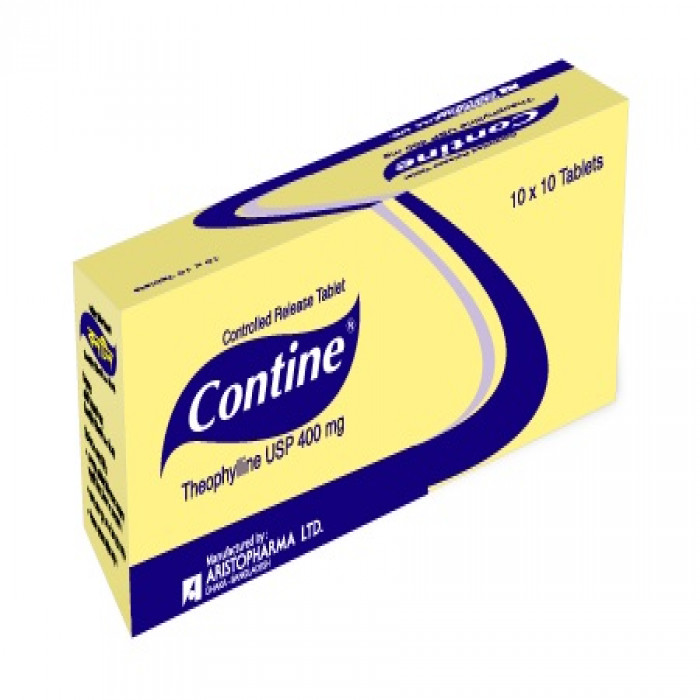
✔ 100% Authentic Product
👁️ Currently Viewing 1265
Contine 400mg 10Pcs
Tablet Manufacturer/Distributor: Aristopharma Limited Generic Name: Theophylline anhydrous 400mgl tablet (sustained release)
Discount
Price: ৳ 28
MRP:
৳
29.89
6%
Off

100% Genuine Products, Guaranteed

Safe & Secure Payments, Always

Fast, Secure & Efficient Delivery

Proper Packaging
 Cash on Delivery - All over Bangladesh
Cash on Delivery - All over Bangladesh Regular Delivery - 12-24 Hours, Dhaka City* Charge Tk.39-59
Regular Delivery - 12-24 Hours, Dhaka City* Charge Tk.39-59 Regular Delivery - 24-48 Hours, Other Cities* Charge Tk.99-110
Regular Delivery - 24-48 Hours, Other Cities* Charge Tk.99-110
 ফ্রি ডেলিভারিঃ - ৯৯৯ টাকা+ অর্ডারে, ঢাকা
শহরে
ফ্রি ডেলিভারিঃ - ৯৯৯ টাকা+ অর্ডারে, ঢাকা
শহরে ফ্রি ডেলিভারিঃ - ২৯৯৯ টাকা+ অর্ডারে, ঢাকার
বাহিরে
ফ্রি ডেলিভারিঃ - ২৯৯৯ টাকা+ অর্ডারে, ঢাকার
বাহিরে
100% Genuine Products, Guaranteed
Safe & Secure Payments, Always
Fast, Secure & Efficient Delivery
Proper Packaging
 Cash on Delivery - All over Bangladesh
Cash on Delivery - All over Bangladesh Regular Delivery - 12-24 Hours, Dhaka City* Charge Tk.39-59
Regular Delivery - 12-24 Hours, Dhaka City* Charge Tk.39-59 Regular Delivery - 24-48 Hours, Other Cities* Charge Tk.99-110
Regular Delivery - 24-48 Hours, Other Cities* Charge Tk.99-110 ফ্রি ডেলিভারিঃ - ৯৯৯ টাকা+ অর্ডারে, ঢাকা
শহরে
ফ্রি ডেলিভারিঃ - ৯৯৯ টাকা+ অর্ডারে, ঢাকা
শহরে ফ্রি ডেলিভারিঃ - ২৯৯৯ টাকা+ অর্ডারে, ঢাকার
বাহিরে
ফ্রি ডেলিভারিঃ - ২৯৯৯ টাকা+ অর্ডারে, ঢাকার
বাহিরে
✅ Description:
Indications
Theophylline is used to treat acute asthma attacks.
Chronic asthma management (For both Symptomatic and prophylactic treatment).
For nighttime asthma and early morning wheeze management.
Acute exacerbation of chronic obstructive pulmonary disease (Chronic bronchitis and emphysema) and management of chronic obstructive pulmonary disease (Chronic bronchitis and emphysema).
Control of prematurity apnea.
Pharmacology
Theophylline is a bronchodilator categorized as a Methylxanthine structurally. Smooth muscle relaxation and inhibition of the airways' responsiveness to stimuli are two different effects of theophylline in the airways of individuals with reversible blockage. Theophylline also enhances the power of diaphragmatic muscle contraction. A number of known factors impact the half-life of theophylline. The half-life of adult nonsmokers with uncomplicated asthma ranges from 3 to 9 hours.
Dosage & Administration
The dose of theophylline must be individualized on the basis of peak serum theophylline concentration measurements in order to achieve a dose that will provide maximum potential benefit with minimal risk of adverse effects. Most of the sustained release preparations may be administered every 12 hours in adults while administration every 8 hours may be necessary in some children with markedly rapid hepatic
metabolism of theophylline. The recommended maintenance dose within accepted therapeutic range is as follows :
16 years or older: 10 mg/Kg/day (Do not exceed 900 mg/day)
12 years-15 years: 13 mg/Kg/day
9-11 years: 16 mg/Kg/day
1 year-8 years: 24-24 mg/Kg/day
6 months-1 year: 12-18 mg/Kg/day
1-6 months: 10 mg/Kg/day.
Interaction
Theophylline should not be used simultaneously with other preparations containing xanthine derivatives. Barbiturates, carbamazepine, lithium, phenytoin, rifampicin, and sulfopridone can increase theophylline clearance, so an increased dose may be required. On the other hand, allopurinol, cimetidine, ciprofloxacin, corticosteroids, erythromycin, furosemide, isoproterenol, oral contraceptives, and thiabendazole reduce the drug clearance rate, so it may The dose needs to be reduced to avoid side effects. Theophylline can aggravate hypokalemia caused by β2 receptor agonist therapy, steroids, diuretics, and hypoxia, so serum potassium levels should be controlled in this case.
Contraindications
Patients who are hypersensitive to theophylline or any other component of the product should avoid using it.
Side Effects
At regular dosages, adverse effects are uncommon. GI pain, headaches, nausea, sleeplessness, and hypotension are all possible symptoms. Diuresis and CNS stimulation are also possible, especially in youngsters.
Pregnancy & Lactation
It is unknown if theophylline can damage a developing fetus when given to a pregnant woman. Only if obviously needed should xanthines be administered to a pregnant lady. In nursing human babies, theophylline is secreted in breast milk and may induce agitation or other indications of moderate poisoning. Unless the mother has hazardous serum Theophylline concentrations, serious adverse consequences in the child are unlikely.
Precautions & Warnings
Various interacting medications and physiologic circumstances that might affect Theophylline clearance must be carefully considered. Before to starting Theophylline therapy, prior to increasing the Theophylline dose, and throughout follow-up, dosage adjustments are necessary. The dose of Theophylline used for beginning of therapy should be modest and gradually raised over time if tolerated.
Storage Conditions
Keep all medicines out of reach of children. Store in a cool and dry place, protected from light.
⚠️Disclaimer:
At ePharma, we’re committed to providing accurate and accessible health information. However, all content is intended for informational purposes only and should not replace medical advice from a qualified physician. Please consult your healthcare provider for personalized guidance. We aim to support, not substitute, the doctor-patient relationship.






